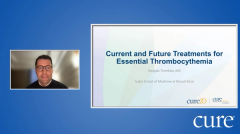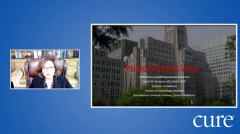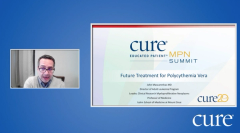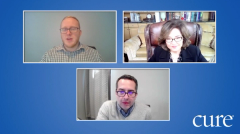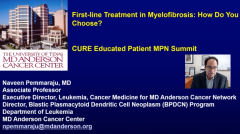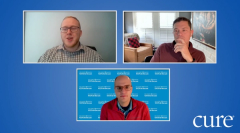
Educated Patient® MPN Summit Essential Thrombocythemia Panel: November 19, 2022
Watch Dr. Aaron Gerds and Dr. Douglas Tremblay answer questions about essential thrombocythemia during the CURE Educated Patient MPN Summit.
Episodes in this series

This panel was moderated by Ryan McDonald and featured Dr. Aaron Gerds, from Cleveland Clinic, and Dr. Douglas Tremblay, from Mount Sinai, who answered questions about essential thrombocythemia (ET).
McDonald: Dr. Gerds, we had a question come in from an audience member. Someone wondered if anyone over 60 is in that high-risk category. So there may have been some confusion about who is that high-risk (group) or not?
Gerds: Yeah, excellent question. The first follow-up question is risk for what? So we really think about risk in two ways in essential thrombocythemia. One is the risk of thrombosis or blood clots. Dr. Tremblay laid out nicely a major complication and predictor for things to come with this disease. So we want to think about who's at higher risk for blood clot. Now, just because you're older doesn't necessarily mean you're at higher risk for blood clots. Our risk (goes) up as we all age. So that's why age is a risk factor. But it is not the sole determinant. So, say you were a person who had a calreticulin mutation and you were older, you wouldn't necessarily be higher risk than that point. It's really for the patients who have either had a prior thrombosis, a prior blood clot that is, or those who are older and have a JAK2 mutation. Those are the folks who are considered highest risk for blood clots going forward.
For overall risk, which accounts not only for blood clots, but other factors that may impact survival as well as even disease progression to a certain degree. That kind of overall survival risk is a little bit more complicated. Age is included in that as well. But we also think about often those other mutations outside of the typical JAK STAT activating mutations. … And so those are kind of the other key factors that can drive risk. Again, a younger patient or an older patient who has just a type 1 calreticulin mutation only and no other real risk factors, we wouldn't consider them necessarily high risk, we would want to see other things that would increase the risk as long as well with that.
McDonald: Okay, thank you. Now, Dr. Tremblay, you presented in part on the management of ET and you alluded to how after second-line treatment, there's little available on the market there. This year marks CURE’s 20th anniversary, so, in keeping with that theme, how far would you say we've come in managing this disease? And how far do we still need to go?
Tremblay: That's a great question. You know, I think that we have really made some gains in the last 20 years. And in many ways, I think, as Dr. Gerds outlined, we've come a long way in terms of understanding individual patient risks, and incorporating mutational information has really refined those patients who may benefit most from intervention and patients who may not benefit from intervention. And there's been some seminal studies really understanding the use of available cytoreductive therapy, specifically hydroxyurea pegylated interferon and trying to understand which drugs are better, what their roles are.
(What is) maybe evident is a lot of the agents that we’re using … these are old drugs that have been on the market for a long time. And while we've made advances in understanding their use and the appropriate use, there has been not as much development in essential thrombocythemia in terms of new agents that may be the frontier in the next generation. And, that's partly our fault in not really trying to push this forward.
It's also a very difficult disease to study. I mean, the majority of patients who have essential thrombocythemia, thankfully, have a relatively indolent course with thrombosis and transformation happening in the minority of patients. So in order to see if an intervention, say a new drug, really prevents something, it requires long studies that include lots of patients, that can be very challenging and expensive to run. So that has really hampered our ability to really design new therapies. Now, thankfully, we've learned a lot more about the biology of the disease in the last few decades. And now we're learning a lot more, testing more things out that are more targeted and specific for essential thrombocythemia. So because of these translations from the laboratory, I think we're able to overcome some of the limitations that we've had in the past and really understand some new therapies that may not only just prevent blood clots, which is really key, but also prevent disease progression and attack the stem cell where the disease really resides. And so I think even though the last 20 years have had some advantages, but I'm most excited for (CURE’s 40th anniversary) when we're talking about what happens with all of these new immune therapies and how we can think about for stratification even better, and what does the next generation of treatments look like for this disease?
Gerds: Okay, I’d just like to add a quick point and echo what you said, I think one of the biggest advances in the last couple of years have been just treating people less, right? Our available treatments don't make them any better or make them live any longer … (But taking) a look at clinicaltrials.gov, which is the clearinghouse for all these clinical trials online, as you know, and it showed the number of hits for ET, (polycythemia vera) and myelofibrosis versus say, like breast cancer, or pancreas cancer, and showing that and advocating really for more clinical trials and more work, like the stuff that you showed in your presentation. We need to do more of that, to get new treatments for these folks. If you look at clinicaltrials.gov, there's maybe 200-some-odd trials listed for ET, and you look at something like breast cancer, although breast cancer is very common and much more common. I mean, you'll see thousands and thousands of trials on there. So I think we need to maximize what we're doing to try to deliver new therapies.
Tremblay: I 100% agree to that's an excellent point.
McDonald: Thank you, Dr. Gerds. We’ve talked about treatment options and looking ahead and everything. But one question that came in, actually which I'm curious about,… if say a patient has an autoimmune disease, as well as E , are there any different approaches or treatments that can't be used? How does that work?
Gerds: Yeah, I think, it depends on the autoimmune disease. You know, autoimmune disease often increases thrombosis risk. So although it's not part of our traditional models for thinking about that, it might be something worth considering. The second thing is that some of the treatments we use for treating MPN are anti-inflammatory, and you might get a two-for-one, if you will. So JAK inhibitors being the prime example. There are JAK inhibitors approved for rheumatologic disorders, as well as JAK inhibitors approved for treating MPN. And you may select one of those JAK inhibitors for one or the other disease to try to hit two birds with one stone.
But certainly thinking about therapeutics as well, Dr. Tremblay pointed out very astutely that there is no magic platelet count number. And I think one of the things to consider if you also have an autoimmune disorder, if that autoimmune disorder is out of control, that may increase the platelet counts. So you also want to consider that too. So certainly, I think the important thing at the end of the day is a collaboration between the patient, the hematologist and the rheumatologist all working together. So everyone's on the same page.
McDonald: Now, Dr. Tremblay, Dr. Gerds just alluded to JAK inhibitors, and we had a question come in here, which once again, I'm kind of curious to hear you talk about JAK2 allele burden and what that means and if patients should even consider or be weary of that?
Tremblay: Yeah, it's an excellent point. And so JAK2 burden is really a reflection of the amount of JAK2 mutation that's present in the blood and it's measured from the peripheral blood or from the bone marrow aspirate, and gives you an idea of if there's a percentage from zero to 100 of what the kind of dose of JAK2 is in there. JAK2 allele burden has been evaluated in a number of myeloproliferative neoplasms, mostly polycythemia vera and showed to be a strong predictor for thrombosis progression and death. And I think that that slide that Dr. Gerds brought up with the engine in the car is an excellent analogy for that.
So in that analogy, a higher JAK2 burden would be more consistent with like a higher speed engine versus a lower JAK2 burden. And we know though, that patients with essential thrombocythemia versus polycythemia vera generally have a lower JAK2 burden than polycythemia vera patients, and the data to suggest thrombosis connections is just not a strong in essential thrombocythemia, especially because the variability in the disease is slightly less.
Now, when we think forward about therapeutics, though, drugs that really reduce the amount of JAK2 burden over time. That is thought to be a favorable effect because it suggests that the amount of mutant CHEK2 is reducing so maybe you're having an effect on the stem cell. So, for instance, pegylated interferon in polycythemia vera over time will reduce the amount of JAK2 allele burden in patients over prolonged periods of treatment. And that's thought to really say you're working at the stem cell level too. Now I will say a little bit of caution that we don't yet know for sure if reducing JAK2 allele burden means less disease progression or less thrombosis. So those studies really need to be executed for us to say JAK2 allele burden is not only a risk factor, but it's an end point that we want to try to reduce that is something that's favorable. While we think that it probably is favorable, the studies don’t really exist yet to show definitively that that's something that is beneficial for a patient and the outcomes that really matter. So it is a very important measure. But in terms of other myeloproliferative neoplasms, it's probably the less important versus polycythemia vera or myelofibrosis where it can be diagnostically and prognostically important as well.
McDonald: Thank you. So, Dr. Gerds, back over to you. Dr. Trembley alluded to this during his presentation about certain side effects associated with treatments such as you know, change in taste. So how do you advise patients on the risk for these side effects and how to manage them? And also actually another question, some people are saying, if I'm having side effects that aren't on those sheets, how do I know if that's a part of treatment or not?
Gerds: Yeah, I mean, that's always a tough one because a lot of side effects can come from a lot of different symptoms that are from a lot of different places. So is it coming from the disease? Is it coming from the treatment that you're on for that disease? Or is it coming from something completely different, a different disease or different treatments?
Fatigue being one of those things. Certainly ET can cause fatigue, treatments for ET can cause fatigue, other things like sleep apnea can cause fatigue. And like other medications, even like a blood pressure medicine can cause fatigue. So where's that coming from? And so you have to be like a detective sometimes. One of the best tools we have is a simple postulate where if you think it's a side effect, you stop the medication or reduce the dose. If the side effect gets better, well, that's some evidence. And then if you restart the medication, or go back up to the original dose, and the side effect comes back, or the symptom comes back, then there's clearly a side effect, you know that for sure. So that's really the true way to do it.
When we're looking at clinical trials, unfortunately, the way it's done is, if a patient has an experience, a symptom or an event happen, we catalog that and then we say, “Yeah, that was probably due to drug or no, it maybe wasn't.” And that's honestly how these things come about, especially in nonrandomized trials. At least in randomized trials that are blinded, we can look and compare the two groups. But for the most part, it's just kind of best guess or best judgment. And that's not very scientific or reassuring. So at the end of the day with an individual who has experienced what we think is a side effect, we have to think about it very critically and say, “Well, is this likely? Has this been reported before? Even if it hasn't, maybe trying to take a little bit of a drug holiday to see if it gets better or goes away to really get out there. In fact, is this truly a side effect? Or should we be hunting for something else?”
McDonald: Okay, thank you. Dr. Tremblay, we had an audience member ask this question: How, if any, does Von Willebrand (disease) affect the risk for thrombosis?
Tremblay: Yeah, so that's a great question. So Von Willebrand (disease occurs) because of high platelets that really affect the risk of bleeding, not thrombosis. And so, we typically don't measure Von Willebrand (disease) as a thrombotic risk factor. So if you have even a high platelet count or not so high platelet count with essential thrombocytopenia, and we check your Von Willebrand factor and it's normal or high, we don't say you're at increased risk for thrombosis. The way we really measure it is in the setting if you have a very high platelet count, or if you have bleeding while taking a having a high platelet count or having ET or being on aspirin. And we measure this in order to see if you do have this acquired Von Willebrand disease. And it's important for us to understand that because that may be someone who asked for it isn't such a good idea for and it's someone that we might want to lower the platelet counts with the medication like hydroxyurea or pegylated interferon to lower the platelet counts to prevent that Von Willebrand (disease), but it doesn't have so much of a connection with thrombosis.
McDonald: Okay, thank you. Dr. Gerds, Dr. Tremblay, in his presentation, highlighted that Besremi (ropeginterferon alfa-2b-njft) is FDA approved at least since November of 2021, and stated it was the first proof option that patients could take, regardless of previous therapies. How big of an advancement was that? And what does that mean for everyone out there?
Gerds: Well, I could go on and on about this, especially considering the development of guidelines and things like that. So just to clarify, it is approved for polycythemia vera, Irrespective of line. It's line agnostic; there's no mention of first-line, second-line, like (Jakafi [ruxolitinib]) is after hydroxyurea. It's both a blessing and a curse, I would say. It's great that we have the flexibility to have a label indication with some flexibility in it because we know it can be very effective in the frontline setting. The curse is the fact that it's not very specific, and it does cost more, and considering our health care system here in the United States, it's sometimes difficult to deliver care due to insurance and coverage for these medications, especially expensive medications. And so where you may want to use it in the front line. Sometimes you can get beleaguered by insurance approvals. And even though again, it's line agnostic, insurance companies may say, “Well, it's a lot more expensive than say, hydroxyurea, which is pennies on the dollar.” And so it can really be difficult to, especially after you've had that kind of informed discussion with the patient and you prescribe the medication, and then all of a sudden, you have a month or two worth of wrangling with an insurance provider just to get it paid for.
McDonald: To follow up on that, too, for patients that are out there, right, who are kind of dealing with that back and forth and that struggle and everything, how do you give them hope or set them at ease, if that's even possible, with this challenge of this never-ending cycle?
Gerds: Well, the first thing I say is write your senator. So advocacy, I think, while it doesn't directly provide hope it, it's probably the greatest way to make an impact. Until we have reform of this system, I don't expect it to change. I think being an active participant in the process can help keep your attitude positive. It's a process, right, and we just have to go through it.
When it comes to insurance companies, you have to write the letters to have the period appears, keep pushing until we can get the treatments for our patients. Luckily, some of us have nice infrastructure at our institutions to help with that. But you have to have some persistence to get through it all. But you know, I always tell folks advocate for yourself. Your senators, your representatives, big picture stuff, this is the only way we're going to get these things to change.
McDonald: Dr. Tremblay, a question came in: Is an absolute cure impossible without eliminating the genetic mutation? Or is that the only course?
Tremblay: I think cure is a tough word. That and I think that it might mean different things to different people, too. And, you know, if cure means having a long, healthy life without symptoms of the disease, I think that's absolutely possible without removal of the mutation. If cure means having zero risk of ever having any problems, I think that's going to be tough without real control of the underlying disease and biology. These are all diseases that are in the stem cell and these diseases, as Dr. Gerds had mentioned, that are highlighted by JAK STAT, a hyper activation driven by these mutations, those need to be corrected to really reduce those risks completely. So I think that removal of the mutation and therapies, which may be discussed in the future, taking those lessons from allogeneic stem cell transplants in immune therapy, and moving that in earlier lines in less toxic ways, such as these vaccines and immunotherapies and antibodies to really target the mutation, I think that holds a lot of progress and promise to really control the disease. So while I want to be cautious and not be too optimistic, I am very much looking forward to this next generation of therapeutics for really being able to fulfill that sort of promise to have patients live longer, healthier, happier lives with ET.
Transcription edited for clarity.
For more news on cancer updates, research and education, don’t forget to

